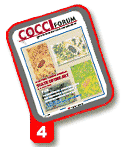Optimal results
Study shows coccidiosis vaccination doesn't deter CE products from protecting birds against Salmonella enteritidis
 Chapman and feathered friend in
the lobby of the Center of Excellence
for Poultry Science, University of
Arkansas.
|
A team of scientists in the world's
second largest poultry market,
Brazil, has determined that coccidiosis
vaccines do not compromise
the ability of "competitive exclusion" or
CE products to protect birds against
Salmonella enteritidis (Se).
"We found that the actions of ACM
(anaerobic cecal microflora) against
cecal colonization and fecal excretion
of Se are not affected by the use of coccidiosis
vaccine in broiler chicks," says
veterinarian and lead investigator
Raphael Lucio Andreatti Filho, a professor
of poultry pathology at the
Universidade Estadual Paulista,
Botucatu, São Paulo.
"Moreover, our results show that the
ACM-coccidiosis vaccine combination
can be used without reduction of the
effectiveness of ACM," adds Andreatti
Filho, who conducted the trial with
ornithopathologists Plínio Mestrinel
Junior and Homero Marcos Sampaio,
plus statistician Adalberto José Crocci.
Understanding CE
CE products such as ACM help to maintain
a healthy balance of microflora in
the gut, thereby increasing the bird's
natural resistance to disease-causing
bacteria such as Se. This is important
because Se is one of the most significant
forms of salmonellae that is transmissible
from chickens to humans.
Even when broiler performance is not
compromised by Se, the organism creates
a serious public health problem -
namely, food poisoning.
Se also can create a health problem
for young or stressed birds. (With adult
birds, the Se is sometimes present, but
the birds don't necessarily have the
appearance of being sick.) Research
also has shown that the coccidial organism
E. tenella may prolong the persistence
of Se in the intestine, which in
turn leads to a longer period of Se
exposure in feces.
Field Trial
To see if coccidiosis vaccination had
any effect on the CE product,
researchers in Brazil divided 120 1-dayold
broiler chicks into six groups and
then implemented the following protocols:
"� Group A received ACM by spraying
on day 1, was vaccinated with the live
oocyst vaccine Coccivac-B on day 2
and challenged with Se on day 3.
"� Group B received ACM by intraesophageal
inoculation on day 1, was
vaccinated with Coccivac-B on day 2
and challenged with Se on day 3.
"� Group C received ACM through the
drinking water on day 1, was vaccinated
with Coccivac-B on day 2 and challenged
with Se on day 3.
"� Group D was vaccinated with
Coccivac-B on day 2 and challenged
with Se on day 3, but was not treated
with ACM.
"� Group E was challenged with Se on
day 3, but was not vaccinated or treated
with ACM.
"� Group F, serving as the negative
control, was not vaccinated, challenged
or treated.
For all groups, researchers determined
the colonization of the digestive
tract, the presence of Se in feces and
body weight 2, 7 and 12 days post-challenge.
Se and Coccidiosis: A Costly Pair
Increasing the numbers of salmonellae in the bird's cecum "the pouch where the
large intestine begins "in the presence of coccidial infection may alter the normal
cecal microflora, which are the bacteria and other microorganisms that typically
inhabit the intestine. |
Reduced Se Counts
"The Se count in the feces and cecal
colonization were reduced in all three
ACM-treated groups, mainly those
receiving ACM by spraying and intraesophageal
inoculation," Andreatti
Filho reports.
An increase in cecal colonization
and fecal excretion of Se was observed
in the groups not receiving ACM,
whether vaccinated or not vaccinated
for coccidiosis, he adds.
"The cecum was the main site of
colonization and persistence of Se,"
Andreatti Filho says. "ACM administered
by spraying or intra-esophageal
inoculation reduced Se in feces and the
cecum compared to the group receiving
ACM in drinking water."
With the exception of Group C, only
Group F's protocol (the negative control)
led to a significantly higher body
weight compared to the other groups.
Encouraging Results
"No difference in body weight was
observed between the groups not treated
with ACM and challenged with Se
and vaccinated or not vaccinated
against coccidiosis, thus demonstrating
that the vaccine had no negative influence
on weight gain in chicks challenged
with Se," Andreatti Filho says.
"Using competitive exclusion products
like ACM, a number of researchers
have shown that bacterial cecal
microflora from adult birds can protect
newly hatched chicks challenged with
Salmonella."
In this case, Andreatti Filho
explains, "competitive exclusion"
means that Salmonella and other
pathogens will probably be reduced if
beneficial bacterial microflora arrive
first and establish colonies in the ceca
of broiler chicks. (Usually, competitive
exclusion products are prepared from
undefined ACM cultures, while probiotics
are made from defined cultures
containing one particular type of bacteria
or a prescribed combination of different
bacteria.)
"These are complex concepts
because researchers still have some
doubts about the mechanisms whereby
beneficial bacterial microflora inhibit
pathogens like Salmonellae," Andreatti
Filho emphasizes.
"But it is already known that probiotics
teamed with vaccines can help to
reduce the use of veterinary pharmaceuticals
in broilers. With proper protocols,
these management tools promote
good performance in broilers, while
also reducing Salmonellae."
The results of the work of Andreatti Filho and
his colleagues were highlighted in a paper
entitled "The effect of coccidiosis vaccine on
Salmonella enteritidis colonization in broiler
chicks inoculated with anaerobic cecal
microflora," which was published in Arquivo
Brasileiro de Medicina Veterinária e
Zootecnia 51(4), August, 1999, 311-361.
Source: CocciForum Issue No.4, Schering-Plough Animal Health.







